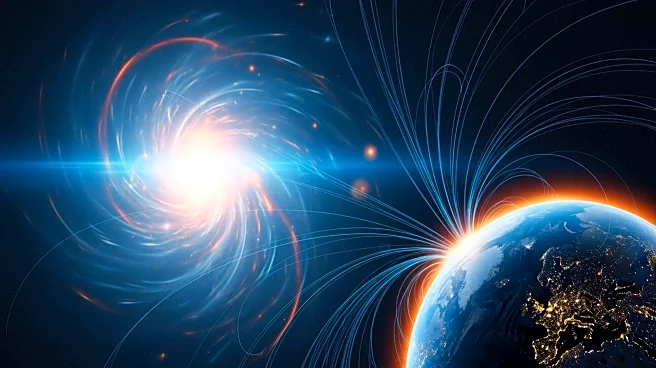What's Happening?
On November 20, 2025, a rare stealth solar storm struck Earth, as reported by scientists at the National Oceanic and Atmospheric Administration (NOAA). This type of solar storm, known as a stealth coronal
mass ejection (CME), is difficult to detect due to its lack of typical solar flare signals. Unlike regular CMEs, stealth CMEs emerge quietly from regions of the Sun with weaker magnetic fields, releasing solar wind that gradually disturbs Earth's magnetic environment. The recent storm led to unexpected aurora displays in regions not typically affected, such as Maine and Denmark, where skywatchers observed striking red and purple auroras. The stealth CME was accompanied by a high-speed solar wind stream from a coronal hole, enhancing its impact.
Why It's Important?
The occurrence of stealth solar storms poses significant challenges for space weather forecasting. These storms can disrupt Earth's magnetic field without prior warning, potentially affecting satellite operations, communication systems, and power grids. The recent event underscores the need for advanced detection methods to identify these subtle solar activities. The unexpected auroras serve as a reminder of the broader impacts of space weather on Earth's environment. As stealth CMEs can produce strong magnetic effects, understanding and predicting these phenomena are crucial for mitigating potential disruptions to technological infrastructure and ensuring the safety of space-based assets.
What's Next?
To improve forecasting of stealth CMEs, scientists are exploring more sophisticated observation techniques, including multi-wavelength and multi-angle solar imaging. These methods aim to detect subtle changes in the Sun's magnetic field that precede stealth eruptions. As research progresses, the goal is to develop more reliable prediction models to provide earlier warnings of such events. This advancement is vital for industries reliant on satellite technology and for regions vulnerable to geomagnetic disturbances. Continued collaboration between space weather agencies and researchers will be essential in enhancing our understanding and preparedness for future stealth solar storms.
Beyond the Headlines
The stealth solar storm highlights the complex nature of space weather and its potential to affect Earth in unexpected ways. The event raises awareness about the need for comprehensive space weather monitoring and the development of resilient infrastructure to withstand geomagnetic impacts. Additionally, the phenomenon offers an opportunity for public engagement with space science, as aurora displays captivate and educate communities about the dynamic interactions between the Sun and Earth. As our reliance on technology grows, understanding space weather's influence becomes increasingly important for safeguarding modern society.













